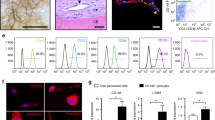Abstract
Recent studies comparing the insulin-producing cell (IPC) differentiation capacity of mesenchymal stem cells (MSCs) derived from four different sources (bone marrow, Wharton’s jelly, adipose tissue, and the periosteum) demonstrated that IPC differentiation of periosteum-derived progenitor cells (PDPCs) progressed faster than any other MSCs within 7 days, indicating that PDPCsare most suited to IPC differentiation. Here, two different cell culture methods, adhesion and cluster culture, were assessed for their ability to support in vitro IPC differentiation. The induction of IPC differentiation was confirmed by RTqPCR analysis of insulin gene expression levels and immunofluorescence analysis of insulin protein. An enzyme-linked immunosorbent assay was used to quantify secreted insulin. PDPC-derived IPCs from cluster cultures demonstrated a significantly increased expression of insulin and an enhanced secretion of insulin of insulin protein in response to glucose compared to IPCs derived from adhesion cultures. Thus, pancreatic islet-like cluster cultures appear to provide the optimal conditions such as cluster culture for IPC differentiation of PDPCs.
Similar content being viewed by others
References
Ryan, E. A., J. R. T. Lakey, B. W. Paty, S. Imes, G. S. Korbutt, N. M. Kneteman, D. Bigam, R. V. Rajotte, and A. M. J. Shapiro (2002) Successful islet transplantation: Continued insulin reserve provides long-term glycemic control. Diabetes 51: 2148–2457.
Shapiro, J., J. R. T. Lakey, E. A. Ryan, G. S. Korbutt, E. Toth, G. L. Warnock, N. M. Kneteman, and R. V. Rajotte (2000) Islet transplantation in seven patients with type 1 diabetes mellitus using a glucocorticoid-free immunosuppressive regimen. N. Engl. J. Med. 343: 230–238.
Kim, H. J., J. S. Yang, and C. Ahn (2009) Current strategies for successful islet xenotransplantation. J. Kor. Soc. Transplant. 23: 214–226.
Vija, L., D. Farge, J. F. Gautier, P. Vexiau, C. Dumitrache, A. Bourgarit, F. Verrecchia, and J. Larghero (2009) Mesenchymal stem cells: Stem cell therapy perspectives for type 1 diabetes. Diabetes Metab. 35: 85–93.
Choi, Y. S., S. E. Noh, S. M. Lim, C. W. Lee, C. S. Kim, M. W. Im, M. H. Lee, and D. I. Kim (2008) Multipotency and growth characteristic of periosteum-derived progenitor cells for chondrogenic, osteogenic and adipogenic differentiation. Biotechnol. Lett. 30: 593–601.
Ferretti, C., V. Borsari, M. Falconi, A. Gigante, R. Lazzarini, M. Fini, R. Di Primio, and M. Mattioli-Belmonte (2012) Human periosteum-derived stem cells for tissue engineering applications: The role of VEGF. Stem Cell Rev. 8: 882–890.
Kim, S. J., Y. S. Choi, E. S. Ko, S. M. Lim, C. W. Lee, and D. I. Kim (2012) Glucose-stimulated insulin secretion of various mesenchymal stem cells after insulin-producing cell differentiation. J. Biosci. Bioeng. 113: 771–777.
Anzalone, R., M. L. Iacono, T. Loria, A. D. Stefano, P. Giannuzzi, F. Farina, and G. L. Rocca (2011) Wharton’s jelly mesenchymal stem cells as candidates for beta cells regeneration: Extending the differentiative and immunomodulatory benefits of adult mesenchymal stem cells for the treatment of type 1 diabetes. Stem Cell Rev. Rep. 7: 342–363.
Lim, S. M., Y. S. Choi, H. C. Shin, C. W. Lee, and D. I. Kim (2005) Isolation of human periosteum-derived progenitor cells using immunophenotypes for chondrogenesis. Biotechnol. Lett. 27: 607–611.
Timper, K., D. Seboek, M. Eberhardt, P. Linscheid, M. Christ- Crain, U. Keller, B. Müller, and H. Zulewski (2006) Human adipose tissue-derived mesenchymal stem cells differentiate into insulin, somatostatin, and glucagon expressing cells. Biochem. Biophys. Res. Commun. 341: 1135–1140.
Joo, D. J., J. Y. Kim, J. I. Lee, J. H. Jeong, Y. Cho, M. K. Ju, K. H. Huh, M. S. Kim, and Y. S. Kim (2010) Manufacturing of insulinsecreting spheroids with the RIN-5F cell line using a shaking culture method. Transplant. Proc. 42: 4225–4227.
Majd, H., P. J. Wipff, L. Buscemi, M. Bueno, D. Vonwil, T. Quinn, and B. Hinz (2009) A novel method of dynimic culture surface expansion improves mesenchymal stem cell proliferation and phenotype. Stem Cells 27: 200–209.
Chao, K. C., K. F. Chao, Y. S. Fu, and S. H. Liu (2008) Islet-like clusters derived from mesenchymal stem cells in Wharton’s jelly of the human umbilical cord for transplantation to control type 1 diabetes. PLoS ONE 1: 1–9.
Jiang, J., M. Au, K. Lu, A. Eshpeter, G. Korbutt, G. Fisk, and A. S. Majumdar (2007) Generation of insulin-producing islet-like clusters from human embryonic stem cells. Stem Cells 25: 1940–1953.
Okura, H., H. Komoda, Y. Fumimoto, C. M. Lee, T. Nishida, Y. Sawa, and A. Matsuyama (2009) Transdifferentiation of human adipose tissue-derived stromal cells into insulin-producing clusters. J. Artif. Organs. 12: 123–130.
Author information
Authors and Affiliations
Corresponding authors
Rights and permissions
About this article
Cite this article
Kim, SJ., Choi, YS., Kim, SM. et al. Pancreatic islet-like clusters from periosteum-derived progenitor cells. Biotechnol Bioproc E 18, 1116–1121 (2013). https://doi.org/10.1007/s12257-013-0005-1
Received:
Revised:
Accepted:
Published:
Issue Date:
DOI: https://doi.org/10.1007/s12257-013-0005-1




